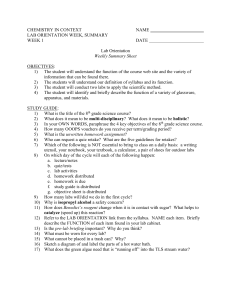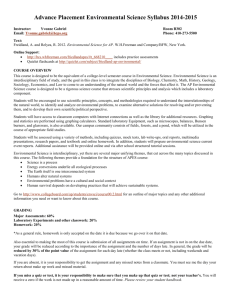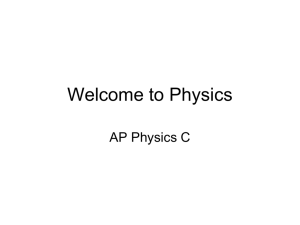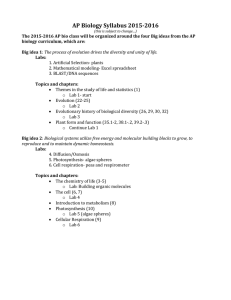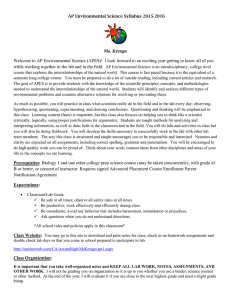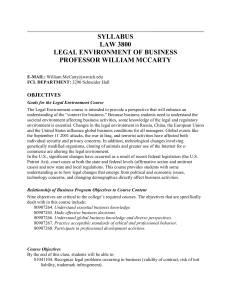AP Environmental Science - MsWold - home
advertisement
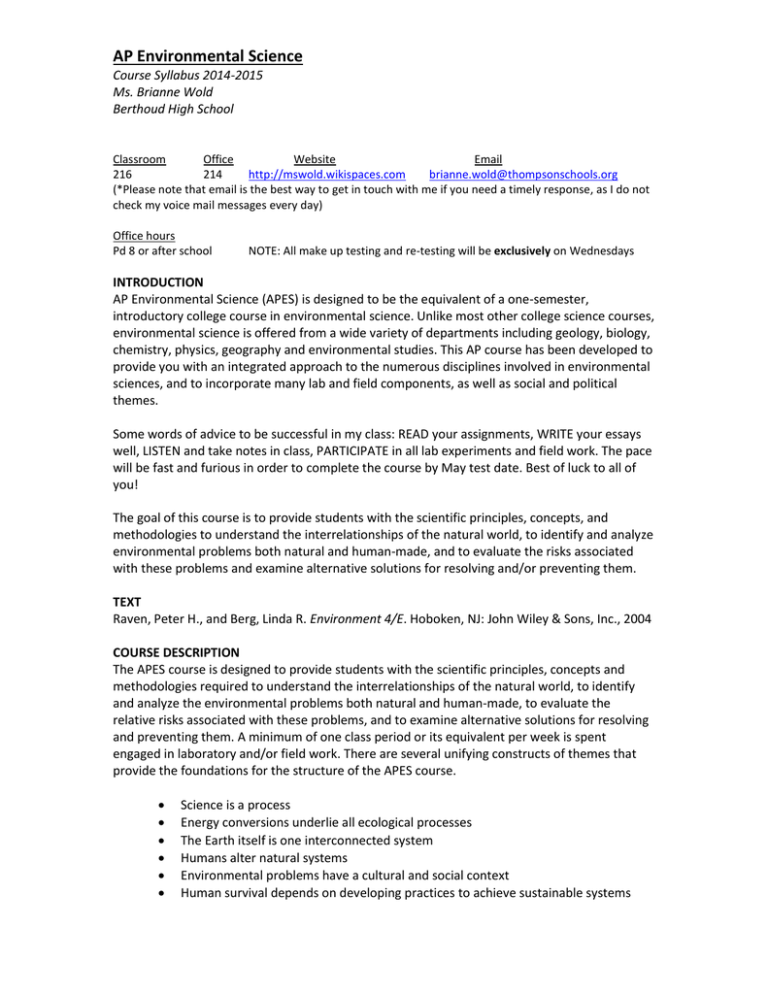
AP Environmental Science Course Syllabus 2014-2015 Ms. Brianne Wold Berthoud High School Classroom Office Website Email 216 214 http://mswold.wikispaces.com brianne.wold@thompsonschools.org (*Please note that email is the best way to get in touch with me if you need a timely response, as I do not check my voice mail messages every day) Office hours Pd 8 or after school NOTE: All make up testing and re-testing will be exclusively on Wednesdays INTRODUCTION AP Environmental Science (APES) is designed to be the equivalent of a one-semester, introductory college course in environmental science. Unlike most other college science courses, environmental science is offered from a wide variety of departments including geology, biology, chemistry, physics, geography and environmental studies. This AP course has been developed to provide you with an integrated approach to the numerous disciplines involved in environmental sciences, and to incorporate many lab and field components, as well as social and political themes. Some words of advice to be successful in my class: READ your assignments, WRITE your essays well, LISTEN and take notes in class, PARTICIPATE in all lab experiments and field work. The pace will be fast and furious in order to complete the course by May test date. Best of luck to all of you! The goal of this course is to provide students with the scientific principles, concepts, and methodologies to understand the interrelationships of the natural world, to identify and analyze environmental problems both natural and human-made, and to evaluate the risks associated with these problems and examine alternative solutions for resolving and/or preventing them. TEXT Raven, Peter H., and Berg, Linda R. Environment 4/E. Hoboken, NJ: John Wiley & Sons, Inc., 2004 COURSE DESCRIPTION The APES course is designed to provide students with the scientific principles, concepts and methodologies required to understand the interrelationships of the natural world, to identify and analyze the environmental problems both natural and human-made, to evaluate the relative risks associated with these problems, and to examine alternative solutions for resolving and preventing them. A minimum of one class period or its equivalent per week is spent engaged in laboratory and/or field work. There are several unifying constructs of themes that provide the foundations for the structure of the APES course. Science is a process Energy conversions underlie all ecological processes The Earth itself is one interconnected system Humans alter natural systems Environmental problems have a cultural and social context Human survival depends on developing practices to achieve sustainable systems The APES course has seven main topics: 1. Earth Systems and Resources 2. The Living World 3. Population 4. Land and Water Use 5. Energy Resources and Consumption 6. Pollution 7. Global Change METHODS Instruction consists of a variety of approaches including, but not limited to, lectures, demonstrations, class discussions, case studies, fieldwork, field studies, laboratory investigations, research projects, computer programs, interactive activities, and in-class assignments. For each unit, there are assigned questions from the book that are due at the end of the unit as well as AP style essay questions given randomly throughout the units. Lab reports and analysis questions are required on most of the labs and fieldwork. All labs are studentconducted unless indicated otherwise. Homework, project research, and reading the textbook are all expectations of the class. You will not have homework every night, but you will find the required reading and overall workload while difficult, is manageable. No late assignments will be accepted without excused absences (see MAKE UP WORK for details). It is important to stay motivated all year, especially towards the exam date when many people have lots of AP exams to prepare for. To stay motivated we will celebrate birthdays, important scientific dates (don’t forget “mole day”), and try to enjoy the learning process and each other! With permission from our district office, this class spends a large amount of time in the field either doing lab work or visiting pertinent study areas during our assigned class period. Our class periods are 47 minutes long for 3 days a week, and then one block day with 90-minutes, which allow more flexibility in our field studies. CLASS FORMAT You will be given lecture notes with visuals including teacher-made PowerPoints, which will be available, along with all other handouts, projects and rubrics at my website. Be prepared to take notes and be an active participant in class discussions and all activities. All of your scheduled tests in class will be simulations of the final AP exam, with multiple choice and essay portions. You will have an option to RE-TAKE your objective portion of any test! I generally do NOT return tests, but will give every student the opportunity to re-test on the multiple choice section on the WEDNESDAY following a test. Essays will not be re-scored. I will only count the re-test if you decide to take it, NOT the higher of the two grades! If you are absent, please plan to take your make up test on WEDNESDAYS, and if you want a re-test it will be the following Wednesday. No exceptions will be made for this policy. Other assignments will include essay sets, laboratory pre-labs and write ups, group work computer simulations, quantitative analysis and data sets, research and oral presentations by individuals and teams. The lab group or team will be an integral part of field and lab work, and cooperation and participation is essential. MAKEUP WORK You are expected to do all assignments and no late work will be accepted unless there is an excused absence and must be completed within one school week (school policy). EXCUSED ABSENCE make-up work and lecture notes will be available from your lab partner. (You may also check the set notebook and the front table for handouts.) TESTS All make up testing and re-testing will be exclusively on Wednesday after school. LABS must be made up by appointment most days of the week. This is outside of class time. Your lab partner will need to help you with the lab. SCHEDULE YOUR APPOINTMENT THE DAY YOU RETURN TO CLASS or BEFORE a planned absence. Remember, you have only one week to complete your makeup work. EXCEPTION: Work or tests assigned prior to your absence are due the day you return! THE EXAM The AP Exam is 100 Multiple Choice questions in 90 minutes and four essays in 90 minutes. The essays include one document-based question (DBQ), one data set (quantitative) question, and two more general synthesis and evaluation questions. Test date: Tuesday, May 5, 2015. COURSE PREREQUISITES Students should have completed Geophysical Lab Science and Biology before taking AP Environmental Science. Due to the quantitative analysis that is required in the course, students should also have taken at least one year of Algebra and Chemistry. Because of the prerequisites, APES will usually be taken either junior or senior year. Most important for success in this course is a willingness to work hard! GRADING I adhere to traditional grading scale, and do not curve grades. (90%-100% A, 80%-80% B, etc.) You will have tests over many chapters at a time (refer to the syllabus), formal and informal lab reports, problem solving and data analysis, multiple choice question sets, essays, computer simulations, independent research projects and Internet based assignments. You are expected to keep all papers when returned. ACADEMIC FRAUD Students are expected to write their own lab reports, research and other writing assignments. While you are expected to do your own work, there may be exceptions for group lab reports, and you will be clearly notified when that occurs. Absolutely no plagiarism of any kind will be tolerated. While I understand that students will have similar lab data when in the same groups, it is expected that your data analysis, conclusions and research will be written in your own words. Expect me to be vigilant in checking your references and online sources! You may not claim someone else’s work as your own for a grade in this class! FIELD TRIP PARTICIPATION: You must have a grade of C or better and be participating positively in class to attend a Science department field trip! If you cannot attend, make up assignments may be given as an alternative. Course Schedule *Subject to change UNIT 1 Environmental Issues: Introduction and Historical Perspective AP Content Area Reference: Land and Water Use, Pollution Book Chapters: 1 & 2 Time: approx. 13 classes Concepts Sustainability, Risk Analysis, Tragedy of the Commons, Environmental Ethics, Worldviews, History, Key Contributors, and Natural Resources Labs Tragedy of the Commons– Students simulate unregulated fishing in the ocean using candy and straws to show the concept of Tragedy of the Commons. Old Field/ New Field – succession and soil composition Termite Study – Experimental Design and research Field Work Field Studies High Plains Environmental Center and Centerra Development – Sustainability and Green Building Practices Devil’s Backbone – Land Use Planning North Lake Park – Natural Resources Analysis Assessment Unit Test: 50 Multiple Choice Sep 15 & 2 Free Response Q’s Sep 16 UNIT 2 Ecosystems and Ecology AP Content Area Reference: The Living World, Earth Systems and Resources, Global Change, Pollution Book Chapters: 3, 4, 5 (p 90-99), 6 Time: approx. 17 classes Concepts: Biodiversity, Laws of Matter and Energy, Populations, Communities, Species Interactions, Energy Flow, Biogeochemical Cycles, Biomes, Abiotic Factors, Ecosystem Management, Succession, Invasive Species Labs: Parking Lot Ecology– Modeling Biodiversity Biodiversity and species richness– Experimental Design (EC: grocery store biodiversity) Decomposition and Biodegradable Materials– Using milk and yeast students test various levels of decomposition with oxygen levels. Dissolved Oxygen and Macroinvertebrates– Students collect macroinvertebrates to show oxygen levels that indicate water quality. Vital Commodity – Food Web and Energy Flow Simulation: Students simulate energy movement through a food web. Nitrogen & Biogeochemical Cycling Game Field Work Field Studies: Other: Robert’s Lake Park – Environmental Impact Statement Analysis Rocky Mountain National Park- Elk population/ Biodiversity (Sept 4) Major Project: Create a Management Plan for a Newly Acquired Open Space. This involves students designing and creating interpretive signs that will actually be installed on our local city bike path/trail. This also involves major research on the ecology of this local wetland. Assessment: Unit Test: 50 Multiple Choice Oct 20 & 2 Free Response Q’s Oct 21 UNIT 3 Populations AP Content Area Reference: Land and Water Use, Population, Earth Systems and Resources, Pollution Book Chapters: 8, 9, 14, 18, 19 Time: approx. 17 class periods Concepts: Human Population Studies – Population Control, Demographic Terms and Math, Per Capita Resources, Population Pyramids, Automobile Use, Food Supply, Agriculture, Soils, Land Use Animal Population Studies – Exponential/Logistic Growth, Carrying Capacity, Biotic Potential, Environmental Resistance, r and K Strategists, Survivorship Curves, Population Interactions Labs: Squirrels in a Forest– Carrying Capacity: Designing forests using different types and sizes of oak trees and then determining carrying capacity based on acorn production of trees. World Population Lab– Reading population pyramids Graveyard Smash – Human survivorship Salinization– Testing the effects of soil salinization levels on seed germination. Land Use Planning– Creating a master land use plan for a community. Field Work Field Studies: Other: Aquaculture – Visit Fish Farm/Hatchery Assessment: Unit Test: 50 Multiple Choice Nov 24 & 2 Free Response Q’s Nov 25 Case Studies: Kaibab Deer, Isle Royale Moose/Wolves, Birds of Prey Idaho, Population Growth in Thailand, Aquaculture Math Problems related to population calculations UNIT 4 Energy AP Content Area Reference: Energy Resources and Consumption Book Chapters: 11,12,13 Time: approx. 14 class periods Concepts: Fossil Fuels, Nuclear Energy, Renewable Energy, Conservation and Efficiency, Energy Math and Conversions, Carbon Footprints, Laws of Thermodynamics Labs: Home Energy Audit– Record and calculate approximate personal energy use in the home. Solar Absorption– Calculate and compare the heat-absorbing capacities of various fluids under solar radiation. Virtual Power Plant Tour– Coal-fired and nuclear facilities Measuring Your Impact– Per capita ecological footprint Other: Project: Detailed Power Point Presentations about each energy source including an evaluation of pros and cons of each source. Energy Math Calculations: practice problems AP style Cumulative Final over Unit 1-4 (Finals Week Dec 15-19) -check schedule for time Present projects Jan 6 and 8 (after break) Assessment: UNIT 5 Atmosphere/ Environmental Quality AP Content Area Reference: Pollution, Global Change, Earth Systems and Resources Book Chapters: 7, 20, 21, 23 Time: approx. 12 class periods Concepts: Clean Air Act, Stratospheric Ozone, Acid Rain, Global Warming, Particulate Matter, Major Types of Pollutants, Indoor Pollution, Effects of Pollutants, Toxicology, Pesticides, Ozone Depletion Labs: Acid Deposition Module– Using small scale chemistry, produce NOx equivalent and analyze its effect on the pH of water in various forms. Particulate Matter– Collect and analyze particulate matter from around the school campus. Water Toxicology Other: Video: Inconvenient Truth Creative Writing Assignment- Greenhouse Effect Unit Test: 50 Multiple Choice Jan 30 & 2 Free Response Feb 2 Assessment: UNIT 6 Wildlife AP Content Area Reference: Land and Water Use, Global Change, The Living World Book Chapters: 17 Time: approx. 9 class periods Concepts: Endangered Species Act, Endangered Species, Animal Rights, Wildlife Management, Population Sampling, Zoo Management and Values, Habitat Fragmentation, Island Biogeography, Recap Mammals/ Birds/ and Fish, Biological Diversity Labs: Sage Grouse Wing Study– Population Sampling: Students calculate sex, age, species, and population numbers using grouse wings provided by the Colorado Division of Wildlife. Mark and Recapture– Students use beans to simulate a tag and recapture procedure for calculating population numbers. Field Work Field Studies: Denver Zoo – Endangered Species Mgmt., Species Survival Plans Environmental Learning Center – Urban Wildlife and Island Biogeography Other: Guest Speakers: Northern Colorado Bird Center – Rehabilitation Efforts and Colorado Division of Wildlife – Management Issues Assessment: Unit Test: 50 Multiple Choice Feb 17 & 2 Free Response Feb 19 UNIT 7 Water AP Content Area Reference: Earth Systems and Resources, Land and Water Use, Pollution Book Chapters: 14, 22 Time: approx. 14 class periods Concepts: Water Use and Locations, Water Pollution (types, point and non-point source), Clean Water Act, Groundwater Contamination, Water Quality and Testing (hardness, alkalinity, pH, nutrients, dissolved oxygen), Qualitative and Quantitative Assessments of the Watershed, Damming, Water Management Labs: Water Olympics– Surface Tension and Adhesion/Cohesion Dissolved Oxygen and Primary Productivity– Water Quality Field testing: qualitative and quantitative testing Health In A Bag– Macroinvertebrate testing of waterway health Eutrophication Kit– Ground water contamination– contour mapping Field Work Field Studies: Extensive qualitative and quantitative assessment of local river including testing for hardness, dissolved oxygen, pH, alkalinity, stream flow and velocity, and physical surveys of the river. Other: Guest Speakers/Visits– Northern Colorado Water Conservancy District to study local water management and Water Treatment Plant, as available Video: Cadillac Desert– Mulholland’s Dream, Flow, Metro Water District Berthoud Lake Water Source – Effects of Algae Bloom (University of Buffalo case studies) Unit Test: 50 Multiple Choice Mar 13 & 2 Free Response Mar 16 Assessment: UNIT 8 Forestry, Solid Waste Management, Recap AP Content Area Reference: Land and Water Use, Pollution Book Chapters: 5 (p 99-115), 15, 16, 18, 24, 25 Time: approx. 13 class periods Concepts: Earth history and geologic time scale, Earth dynamics/ plate tectonics/ earthquakes/ volcanism, Rock cycle/ soil formation, Minerals: soils/ erosion/ conservation, Forest Management, Harvesting Techniques, Fire Ecology, Fire Management, Solid Waste Management, Reduce/Reuse/Recycle, Hazardous Waste, Choices for the Future Computer Labs: Porosity and Permeability of Soil Burning Issues CD – Fire Management, USFS and Univ. of Florida Wealth Beneath Your Feet Soils Analysis– Testing various soil samples for different attributes. Physical and Chemical Weathering – The rock cycle and soil formation Field Work Field Studies: Local Burn Site to study damages and effects Landfill to study recycling, hazardous waste, and solid waste- Trace Your Trash Year-end Cumulative Test: April 16 This test mimics the AP test and is given over a three day (or 2 depending) timeframe - 100 multiple choice questions one day and 4 essay questions the next class period. Assessment: Review for AP Exam 4/22- 5/4 *AP Exam May 5 Unit 9: Post exam projects GPS project, virtual tour, etc… Environmental Science Student Lab Safety Contract – WOLD Purpose: Science is a hands-on laboratory class. You will be doing many laboratory activities which may require the use of potentially hazardous materials. Safety in the science classroom is the first priority for students, teachers, and parents. To ensure a safe science classroom, this list of rules has been developed and provided in this safety contract. These rules must be followed at all times. This copy is to be kept in your science notebook as a constant reminder of the safety rules. General Guidelines: 1. Conduct yourself in a responsible manner at all times in the laboratory. Horseplay, practical jokes, and pranks are dangerous and are prohibited. 2. Follow all written and verbal instructions carefully – be sure to read over labs COMPLETELY before attempting to begin, and be sure you UNDERSTAND WHAT IS REQUIRED. Unauthorized experiments are prohibited. 3. Never work alone. Be alert and proceed with caution at all times, and use the buddy system to check for necessary materials. 4. When entering a science room, do not touch ANYTHING until instructed to do so. Always report directly to your assigned seat and wait for directions. 5. NO FOOD, DRINKS, CANDY, GUM, etcetera at any time in the lab – this includes water! You may have water in class during lecture, films, etc, but if lab is involved, there is NOTHING going into your mouth!!! 6. Keep your work area as clean (if not cleaner than) you found it. You are responsible for cleaning up your own messes. If you see someone else leaving a mess, please notify Ms. Wold ASAP – otherwise, any messes left are the responsibility of the CLASS. 7. Keep aisles clear. Keep chairs and bookbags tucked under desks. 8. Know the locations and operating procedures of all safety equipment including the first aid kit, eyewash station, safety shower, and fire extinguisher. Know where the nearest fire alarm and exits are located. 9. Dispose of all waste properly. Sinks are to be used only for liquids designated as acceptable by Ms. Wold. All solids should be disposed of in the proper containers – paper lab trash goes into the trash can, broken glass into the glass disposal box, dissected specimens to the location deemed appropriate by Ms. Wold. If you do not know where to throw something away, ASK FOR ASSISTANCE – DO NOT JUST FIND SOMEWHERE TO STASH IT! 10. Be sure to read all labels and equipment directions carefully. 11. Keep hands away from face, eyes, mouth, and body while using chemicals or preserved specimens. Wash your hands with soap and water after performing all experiments. 12. Clean, rinse, and wipe away all puddles from work surfaces (including the sinks) at the end of an experiment. Return all equipment clean and in working order to the proper location. NEVER LEAVE DISSECTION TOOLS OR SCOPE MATERIALS DAMP!!! 13. Students are never permitted in the science stockroom unless given specific permission by Ms. Wold. 14. Know what to do if there is a fire drill or any other evacuation procedure during a lab; containers must be closed, gas valves turned off, and any electrical equipment turned off and unplugged. 15. Handle all living organisms used in lab in a humane manner. Preserved biological materials are to be treated with respect and disposed of properly. 16. When using scalpels and other sharp instruments, always carry with tips and points aimed down and away from your body. Grasp sharp instruments only by the handles. Clothing: 17. Students will wear safety glasses at all times when chemicals, heat, or glassware are used. There will be no exceptions to this rule! 18. Contact lenses should not be worn when using chemicals – including specimen dissection. See Ms. Wold for more information. 19. Dress properly during a laboratory. Long hair should be caught back, dangling jewelry should be removed, and loose clothing should be secured. Shoes must completely cover the foot – no sandals or open-toed shoes allowed during lab time. Accidents and Injuries: 20. Report any accident (spill, breakage, equipment damage, etc.) or injury (cut, burn, etc.) to the instructor immediately, no matter how trivial it may appear. 21. Students ARE responsible for any breakage or damage done to lab equipment or any other classroom supplies that must be replaced by the school. The instructor will determine replacement/repair charges and the student will be charged the appropriate fees. 22. If a chemical should splash into your eyes or on your skin, notify Ms. Wold and report immediately to the eyewash station and/or safety shower to flush the affected area with water. This page needs to be signed and returned to Ms. Wold ASAP. You are to keep the syllabus and lab rules in your science notebook for quick reference. You must sign for the syllabus AND lab rules separately. By doing so, you acknowledge receipt of these materials AND that you have thoroughly read both documents. Syllabus: I have read the syllabus and am aware of the classroom policies, procedures, and expectations. Student Name (print): ___________________________________________________ Date _________ Student Signature: ___________________________________________________ Date _________ Parent Name (print): ___________________________________________________ Date _________ Parent Signature: Date _________ ___________________________________________________ Lab Agreement: Student: I have read/been explained and agree to follow all of the safety rules set forth for this class. I am aware that any violation of the safety rules or misbehavior on my part may result in removal from the laboratory, office referral, receiving a zero on the assignment, and/or any combination of these consequences. Student Signature______________________________________________ Date ________________________ Parent/Guardian: I have read the safety rules and am aware of the policies and consequences of violation of said rules. Parent Signature_______________________________________________ Date ________________________ Safety Information 1. Does your student have any allergies? If so please list. 2. Does your student have contact lenses? 3. Please list any other important information regarding your student’s capability to do labs. An additional copy of the syllabus and lab rules can be found online on Ms. Wold’s website.

